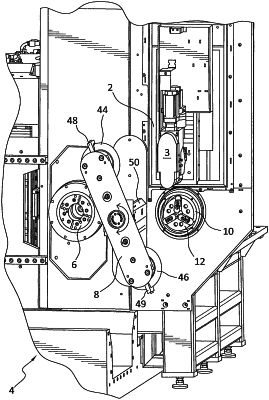| CPC B23Q 17/003 (2013.01) [B23F 23/10 (2013.01); B23Q 7/048 (2013.01); B23Q 17/002 (2013.01); B23Q 17/2291 (2013.01); G05B 19/186 (2013.01); B23F 23/04 (2013.01); G05B 2219/50362 (2013.01); Y10T 409/100159 (2015.01); Y10T 409/100954 (2015.01)] | 11 Claims |

|
1. A method for determining workpiece positioning in a machine tool, said machine tool having a loader mechanism including a means for gripping a workpiece, said loader mechanism being linearly movable along a loader axis by a linear drive means and being angularly movable about said loader axis by a rotary drive means, said linear drive means and said rotary drive means being part of a closed-loop positioning system for said loader axis, said method comprising:
applying a first amount of electric current to the loader linear drive means, said first amount being reduced in comparison to: (i) a defined full power amount of electric current for the loader linear drive means or (ii) a predetermined full power amount of electric current for the loader linear drive means, whereby as a result of the reduced first amount of electric current, the loader linear drive means provides a respective output torque that is reduced in comparison to: (i) a defined full power amount of torque for the loader linear drive means or (ii) a predetermined full power amount of torque for the loader linear drive means,
applying a second amount of electric current to the loader rotary drive means, said second amount being reduced in comparison to: (i) a defined full power amount of electric current for the loader rotary drive means or (ii) a predetermined full power amount of electric current for the loader rotary drive means, whereby as a result of the reduced second amount of electric current, the loader rotary drive means provides a respective output torque that is reduced in comparison to: (i) a defined full power amount of torque for the loader rotary drive means or (ii) a predetermined full power amount of torque for the loader rotary drive means,
positioning the workpiece in a machine spindle of the machine tool and gripping said workpiece with the means for gripping of said loader mechanism whereby said loader mechanism and said machine spindle are mechanically coupled together, said machine spindle being movable along and/or about one or more spindle axes of motion with each of said axes of motion being associated with a respective spindle drive means, wherein each of the spindle drive means outputs a respective torque at a respective defined full power amount or at a respective predetermined full power amount, wherein the reduced output torque of the loader linear drive means and the reduced output torque of the loader rotary drive means are less than the torque(s) at the full power amount(s) of each of the spindle drive means,
wherein as a result of the reduced output torques of the loader linear drive means and of the loader rotary drive means of the loader mechanism with respect to the full power output torque of each of the spindle drive means, said loader mechanism is repositioned linearly in a direction along the loader axis and rotationally about the loader axis whereby machine forces arising from the mechanical coupling are neutralized.
|